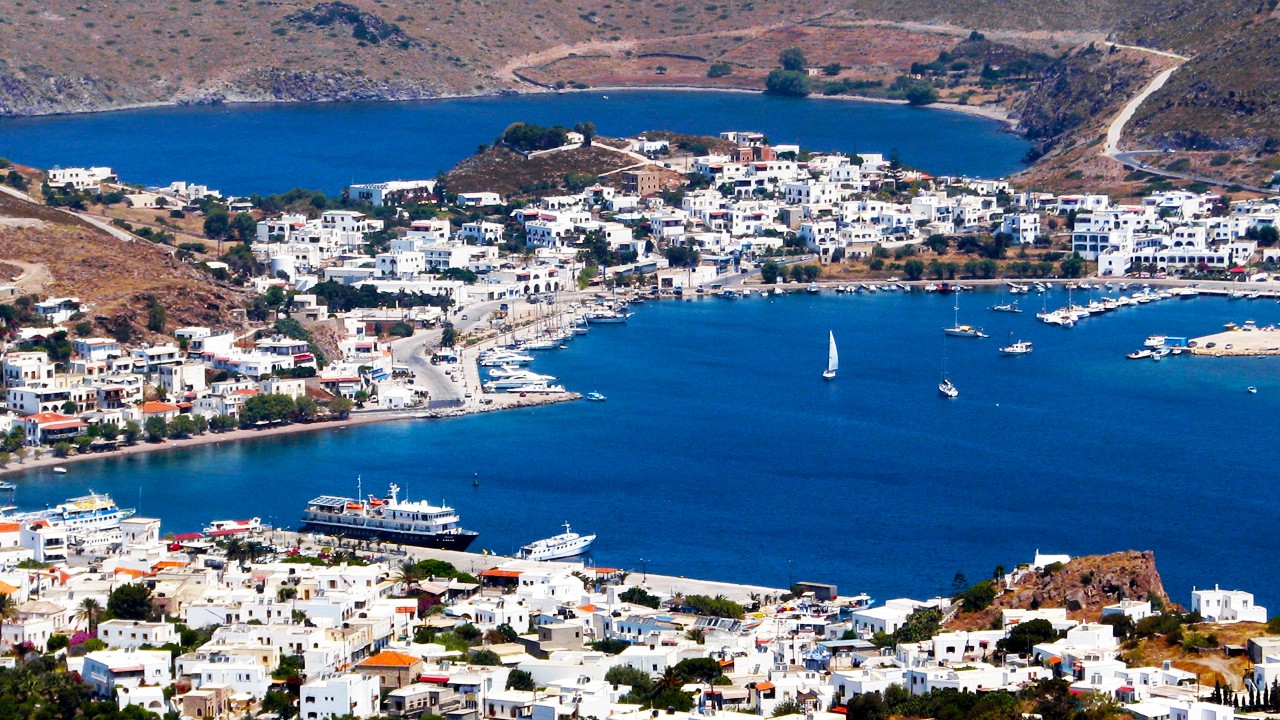Patmos Island
Known as the Jerusalem of the Aegean, Patmos island is the holy island of Christians, where the Apocalypse of St. John was written. Visitors of this Dodecanese island today are split into two groups, the first half that still come to the island because of its religious significance and the second half comes here to enjoy the lovely beaches, the serenity and the unique character of the island and its people. Patmos is a quiet island at night, but a busy stop by day for the many cruise ships that have made it a port of call. Patmos is a spectacular island with great beaches and a unique landscape, an island where tourism until recently was low-key but has been growing steadily. Don't miss the unique Easter celebrations (Greek Orthodox Easter) where you will have the chance to see a staging of Christ's Last Supper. Also, take an evening stroll through the narrow streets of Hora or Chora and watch the sunset from Kastelli hill.
INFORMATION ABOUT PATMOS ISLAND
"The Jerusalem of the Aegean" or Holy island is one way of describing Patmos island. Patmos is distinguished for its beaches and for its imposing 11th century Monastery which is the island's most important landmark. The construction of the monastery began in the 11th century. It is circumscribed by massive walls with battlements that protected the main church and another five chapels. Its extraordinary treasury contains Byzantine and post-Byzantine icons, sacred vessels, 9th century embroideries and other priceless objects, while its library houses parchment documents patriarchal seals, illuminated manuscripts and rare old books. In the chapel dedicated to Our Lady, frescoes can be seen which date to 1210-1220. Patmos, situated between Leros and Ikaria, is a mountainous island with rocky soil and an abundance of small coves. It is 161 nautical miles from Piraeus. The majestic fortress - monastery crowns the hill above the port, surrounded by dazzling white, cube-like houses which spill down its flanks and form the town of Chora. Ships arriving at Patmos dock in the island's harbor Skala, a lively place with its white houses, flowered courtyards, fish tavernas, hotels, restaurants, cafes and shops. North of Skala is the village of Kambos, set among trees and greenery; it is considered by many to be the island's finest beach. There are miles of tracks and lanes around Patmos, many other monasteries and churches to explore and some lovely sand and shingle beaches off the beaten track. There are several other villages worth exploration. The seaside village of Grikos is only 5 km from Skala and has a couple of very good taverns. Other areas worth visiting on Patmos are: Kastelli a 20' uphill walk from the center of Skala where one will see a breathtaking view, and especially at sunset (there is also a small chapel on the summit where there are also remains of a Hellenistic wall); Lefkes which is one of the island's most fertile valleys and produces much of Patmos' fruits and vegetables. Boats from Skala will take you for day trips to the nearby islands of Fourni, Arki , Lipsi and Marathi.
HISTORY OF PATMOS ISLAND
According to mythology the first inhabitants of Patmos island were the God of the sea Neptune and Patmos or Pantos who was none else than the Goddess Diana. The first inhabitants were the Kares in 3000 BC followed by the Dorians and the Ionians. Much later, when the Romans ruled Patmos, the island became an exile place. In 95 AD the exiled St. John the Theologician reached the island and wrote the "Revelation" in a cave which is located at the foot of the monastery. The island goes on to become a place of pilgrimage for the Christians. In 1100 AD the monk Christodoulos founded the Monastery of St. John the Theologician. In 1200 the island was conquered by the Venetians and in 1537 by the Turks. From the end of the 16th century the invaders prosper from trade and the island's shipping. The harbor of Skala becomes the safest and main port in the whole area. Large storehouses are built, castles and rich mansions to protect against attacks from pirates. In 1659 the Venetians destroy the island and in 1669 the island falls under Turkish occupation. The island of Patmos is finally freed in 1948 and united with the rest of Greece
SIGHTSEEING
Some of the most important sites of Patmos are the following:
- Monastery of St. John the Theologician - Cave of the Apocalypse - The women's monastery of Zoodoxos Pigi - Kasteli (in Skala) with remains of an ancient Acropolis - The various little chapels scattered all over the island - Take a daily excursion to the little islets of Arki, Lipsi or Marathi

